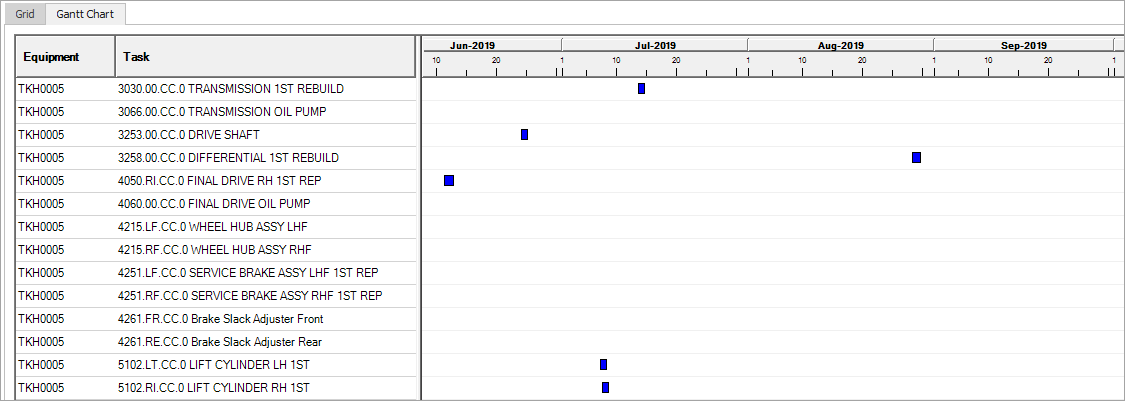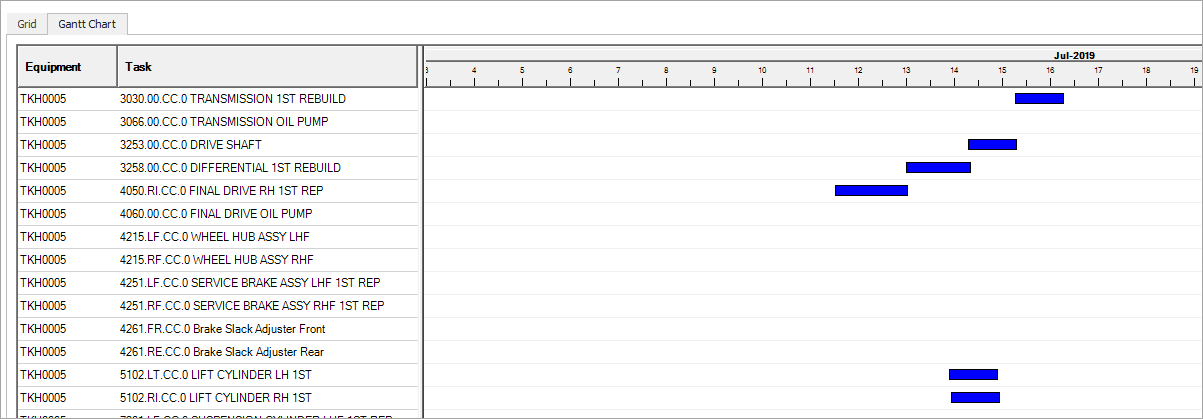Long-Term Planning
Long term planning is based around the concept of ensuring that major maintenance (strategic) tasks have minimal impact on the production and operations targets. To expand on this, it is the formal identification of the major strategy activities and ensuring minimal impact on the production and cost targets by the optimisation of labour resources, parts and materials and tooling through accurate forecasting.
The Long Term Planning module is used to analyse and produce the following information:
- A W+12 forecast for the short term planning and W+1 scheduling cycles
- Provide multiple inputs for the annual budgeting and forecasting cycles
- Availability requirements forecast
- One year and beyond availability and utilisation projections
- Manage lead times on long lead time components
- Identify opportunities to optimise the Dynamic Life Cycle Costing
- Assist in identifying fleet replacement opportunities
Current best practice is to update and produce the W+12 (12 week/3 month) forecast on a weekly basis as an integral part of the short term process, that is, the W+1 maintenance schedule. The maintenance planning horizons are explained in the diagram below.
This is then reviewed with the operations team as part of the initial draft or first cut maintenance schedule and, along with the preventive maintenance services, forms the basis of next week's (W+1) schedule.
Strategy changes applicable only to the next occurrence of a strategy task are called long term planning adjustments. For example:
- For the transmission on a loader, based on condition monitoring analysis, the component may need to be replaced three months earlier than expected.
- For the suspension on a truck there may not be any rotable or service exchange components available when the suspension is due for replacement in three months, therefore new components will have to be used.
These are strategy changes which will only affect the next occurrence, that is, the strategy for the components which are currently in the machine. Changes to long term planning only affect the next occurrence, they do not alter the parameters of the overall maintenance strategy frequency or interval.
The Long-term Planning grid shows all planned strategy tasks for the equipment selected in the filters (non-planned strategy tasks are excluded).
Part of the long term planning process is the alignment or staging of these strategy tasks at a high level. For example, a truck may have the following components come due for replacement within three months of each other:
- Main drive shaft
- Transmission
- Right final drive
- Both lift (hoist) cylinders
- Differential.
Instead of executing each strategy task individually over a longer period, the long term planner would seek to align and stage these tasks to increase uptime by consolidating all these tasks into one major outage. There are many factors to consider. For example, operations may be at a particularly critical phase of the mine plan at this point, and a longer outage may not be feasible for compliance with the mine plan, despite providing better availability overall. The long term planner may have to stage these into two or more shorter events to ensure compliance, but effectively reducing maintenance efficiency in the process.
Once the long term planner has done some basic high-level staging of the strategy tasks to create a consolidation of complimentary tasks, the W+12 forecast is given to the short term planner who fine tunes the staging of the components, parts or services for anything that falls within the W+12 (12 week) forecast.
When these have been planned and the components or parts ordered, the scheduler takes control of the strategy tasks and includes them in the W+1 (weekly maintenance schedule). Click here to see the long term planning process.
Long-term planning screen
Filters
Filters allow you to view, group and sort the tasks to suit the analyses being performed.
Grid fields
| Field | Description |
|---|---|
|
Equip. Plan |
Identification number of a piece of equipment. |
|
Component |
Component code combination of the strategy task followed by the description of the component code. |
|
S |
Suppression grouping. |
|
D |
Dependency grouping. |
|
Job Cost |
Total cost of all jobs associated with the selected strategy task for the next occurrence of the strategy task (expressed in the primary currency). |
|
Duration |
Total job duration of all jobs associated with the selected strategy task for the next occurrence of the strategy task. |
|
Life To Date |
Current life of the component (calculated as current equipment usage – usage of most recent work order settlement for this task). |
|
Strategy Date |
Date at which point the strategy task should be executed. |
|
Strategy Usage |
Usage at which point the strategy task should be executed. |
|
Overdue |
! Indicates that the task should have been completed but it has not (based on strategy date versus today’s date). |
|
Reviewed Status |
Not Reviewed: task’s strategy date or usage values have not been adjusted or validated. Reviewed: task’s strategy date or usage values have been adjusted or validated. Confirmed: task’s strategy date or usage has been locked in. |
|
System Calculate |
A tick will display if the strategy usage or date has been calculated by the system. Once you have determined the optimal life for the component, update the strategy usage or date for the strategy task. This results in the system calculated flag disappearing, and either the strategy date or strategy usage field displaying in light blue. |
|
Message |
Indicates whether an internal conditional based maintenance warning message has been generated. |
|
PCV |
Projected cost variance of the strategy task. (Note: The value will be zero if there is no matching strategy task in the equipment’s budget projection). |
|
RVIC |
% life remaining on the strategy task at present. |
|
Occurrence Type (FM) |
Failure mode (only shown if the strategy task is linked to a component structure). |
|
Measurement/Usage |
Actual measurement or usage reading relevant to the occurrence type. |
|
R1 - RD6 |
Last six actual usage or measurement readings. |
| Task Counter Code | Identifies the strategy task. |
Gantt chart legend
| Bar | Description |
|---|---|
|
|
Overdue (next occurrence). |
|
|
System calculated and not overdue (next occurrence). |
|
|
Not system calculated and not overdue and not confirmed (next occurrence). |
|
|
Confirmed (next occurrence). |
|
|
Future occurrences (beyond the next). |

|
Future occurrence of a strategy task which belongs either to a dependency or suppression scheduling group. |
Quick Buttons
| Button | Description |
|---|---|
|
|
Displays all future occurrences of the strategy task projected. The list is read only and is for information purposes only. |
|
|
Displays the strategy task from the current projection. Again this should only be modified after careful consideration as changes can have wide reaching effects on future projections. |
|
|
Opens the usage profile linked to the selected equipment plan. This should only be modified after careful consideration as changes can have wide reaching effects on future projections. |
|
|
Open the Record Actual Usages function. |
|
|
Displays the work order’s settlement history. If there are errors in any work order settlement, for example a new life event that has been incorrectly coded, then correct the codes of the work order settlement. |
|
|
Component status report. |
|
|
Displays current equipment usage readings and measurements. |
|
|
Usage v Profile Snapshot report. |
|
|
Create a work order settlement for the selected work order. |
|
|
Edit failure mode assessment (CBM Module). |
|
|
Create a backlog work order in planning. |
|
|
Opens the Record Actual Measurements function. |
|
|
Displays the Trending report. |
Reviewing new tasks
When reviewing new tasks, it is best to clear the Include Tasks Outside Planning Window check box so that you can focus on the tasks that have entered the planning window, as they have the highest priority.

Group tasks
When refining the long-term plan you should look for synergies, such as:
- the timing of major shutdowns.
- tasks performed on the same type of component in different locations (for example, aligning left and right cylinders to be performed at the same time).
- minor components with parent components (for example, brakes aligned with final drives).
On the Long-term Planning Gantt chart you can visually group tasks.

















